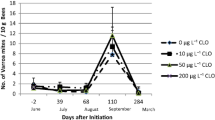Abstract
Temik, the granular formulation of aldicarb [2-methyl-2(methylthio) propionaldehyde 0-(methylcarbamoyl) oxime], was placed together with sugar beet seeds during sowing along the rows, at a rate of 1.4 g/m, in a 1.5-ha experimental area within a 6-ha sugar beet field in an arid area with a long history of bird damage. Thirty-three chukar partridges, a major pest of sprouting crops, were observed foraging in the experimental area throughout the 4-week period between sowing and assessment of damage. Damage was restricted to the borders of the field, with a significant difference in level of damage between treated and control plots located along the borders; the size of damaged areas was about five times smaller in the treated plots than in the control plots. The results were interpreted as reflecting the repellent effect of aldicarb absorbed by the sprouts, and as establishment of a conditioned aversion by the chukars to sugar beet sprouts. The high toxicity of the treated sprouts was demonstrated when adult Japanese quail were fed sprouts collected from treated plots.
Similar content being viewed by others
References
Anon. (1975) Initial Scientific and Minieconomic Review of Aldicarb. U.S. Environmental Protection Agency, Office of Pesticide Programs, Criteria and Evaluation Division, Washington, D.C.
Benjamini, L. (1980) Feeding behavior of the chukar (Alectoris chukar) in sugar beet plantations.Phytoparasitica 8: 3–18.
Benjamini, L. (1980) Bait crops and mesurol sprays to reduce bird damage to sprouting sugar beets.Phytoparasitica 8: 151–161.
Benjamini, L. (1981) The efficacy of seed treatment with aldicarb to establish conditioned aversion in birds to sprouting sugar beet.Phytoparasitica 9: 3–9.
Benjamini, L. (1981) The effect of high-level bird-repellent treatment with aldicarb on the germination and development of sugar beets.Phytoparasitica 9: 11–7.
Dorrance, M.J. and Gilbert, B.K. (1977) Considerations in the application of aversive conditioning.in: Jackson, W.B. and Marsh, R.E. [Eds.]. Test Methods for Vertebrate Pest Control and Management Materials. ASTM STP 625. American Society for Testing Materials, Philadelphia, PA. pp. 136–144.
Hill, E.P. (1972) Avoidance of Iethal dietary concentrations of insecticide by house sparrows.J Widl. Mgmt 36: 635–639.
Rozin, P. and Kalat, J. (1971) Specific hungers and poison avoidance as adaptive specialization of learning.Psychol. Rev. 78: 459–486.
Author information
Authors and Affiliations
Additional information
Publication of the Agricultural Research Organization. No. 171-E, 1981 series.
Rights and permissions
About this article
Cite this article
Benjamini, L. Testing aldicarb as a bird repellent in a sprouting sugar beet field. Phytoparasitica 9, 89–94 (1981). https://doi.org/10.1007/BF03158450
Received:
Revised:
Issue Date:
DOI: https://doi.org/10.1007/BF03158450




